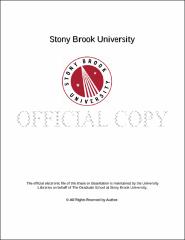| dc.identifier.uri | http://hdl.handle.net/11401/77462 | |
| dc.description.sponsorship | This work is sponsored by the Stony Brook University Graduate School in compliance with the requirements for completion of degree. | en_US |
| dc.format | Monograph | |
| dc.format.medium | Electronic Resource | en_US |
| dc.language.iso | en_US | |
| dc.publisher | The Graduate School, Stony Brook University: Stony Brook, NY. | |
| dc.type | Dissertation | |
| dcterms.abstract | I present a novel multichannel single photon detector based on PMT sensor (32-channel Hamamatsu H7260-20) with unique linearity range for applications in life sciences. My extensive study of pulse characteristics of the PMT sensor showed that maximum linearity range obtained with 32-channel PMT could not exceed 108 counts/sec due to distortions of photon pulses at high input optical power. Due to a novel, highly advanced analog/digital circuitry operating in GHz range, the developed 32-channel detector has a unique performance: it supports detection of up to 108 photons/sec per channel, data acquisition rate at up to 106 frames/sec, data transfer via Ethernet and data recording speed up to 32MB/sec. Utilizing outstanding performance characteristics of the detector it was made possible to develop a unique single photon spectrometer. Having an extremely broad linearity range and high data acquisition speed, the spectrometer has been successfully used for the detection of fluorescent radiation from both single quantum dots (QD) and micro-beads with embedded quantum dots of different colors. Our experiments demonstrated the ability of the spectrometer to detect up to 10000 micro-particles per second. For the beads with embedded quantum dots of 6 different colors we were able to distinguish up to 105 different color combinations (QD fluorescence in spectral range between 490nm and 700nm). Currently, in the field of the molecular biology there is a wide variety of techniques and assays based on color labeled micro- and nano-particles. The unique detection performance of our single photon sensor suggests its successful use in multiple applications such as life sciences, molecular diagnostics, personalized medicine and others. | |
| dcterms.available | 2017-09-20T16:52:44Z | |
| dcterms.contributor | Donetski, Dmitri | en_US |
| dcterms.contributor | Gorfinkel, Vera | en_US |
| dcterms.contributor | Shterengas, Leon | en_US |
| dcterms.contributor | Beznosko, Dmitriy. | en_US |
| dcterms.creator | Gudkov, Dmytro | |
| dcterms.dateAccepted | 2017-09-20T16:52:44Z | |
| dcterms.dateSubmitted | 2017-09-20T16:52:44Z | |
| dcterms.description | Department of Electrical Engineering. | en_US |
| dcterms.extent | 106 pg. | en_US |
| dcterms.format | Monograph | |
| dcterms.format | Application/PDF | en_US |
| dcterms.identifier | http://hdl.handle.net/11401/77462 | |
| dcterms.issued | 2013-12-01 | |
| dcterms.language | en_US | |
| dcterms.provenance | Made available in DSpace on 2017-09-20T16:52:44Z (GMT). No. of bitstreams: 1
Gudkov_grad.sunysb_0771E_11680.pdf: 10411737 bytes, checksum: 2bab457e646719249b36798ae6bb8333 (MD5)
Previous issue date: 1 | en |
| dcterms.publisher | The Graduate School, Stony Brook University: Stony Brook, NY. | |
| dcterms.subject | Electrical engineering | |
| dcterms.subject | fluorescence detection, micro-particles sorting, photomultiplier tube, single photon detector | |
| dcterms.title | Development of a single photon detector for fluorescent spectrometry | |
| dcterms.type | Dissertation | |

